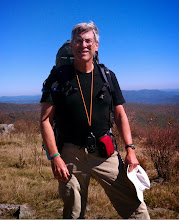Even growing up in the north, I don't remember a lot of focus on slavery during history classes and its importance to our country's history, much less how truly awful it was. There was not a lot of emphasis on the fact that every one of the colonies and original states, plus Canada, had legalized slavery. Every one of the original states, as well as many others, has a slave history. The Slave Trail that I walked here in Richmond helps to preserve that part of our history, communicate it, and hopefully, to allow people to reflect on what it was like and what it meant.

The Slave Trail was completed recently by the City of Richmond to commemorate the countless thousands who were enslaved in Virginia, as well as Richmond's role in the slave trade - especially as a shipping point for the supply of slaves to other parts of the south. A combination of Virginia's soils becoming too poor to sustain tobacco large-scale production, the banning of the trade to ship slaves from Africa to the United States, and the invention of the cotton gin caused the demand for selling established slaves to the plantation owners of the deep south to skyrocket. For the thirty years before the Civil War, Richmond was the largest slave center in the Eastern United States, selling up to 10,000 human beings a month "down the river." Although some slaveholders freed their slaves in this time, many more profited by selling them as they would a horse or a cow or a piece of equipment. Families were torn apart in the process.
The Slave Trail follows peaceful and scenic riverfront woodlands, dramatic city views like this one, and the urban streets where slaves were warehoused, marketed and punished - as well as some milestones to early African life in this region.

I took enough photos and learned enough during my walk that I will be publishing at least one more post about it in the next few days, so look at this post as an introduction and orientation about my walk. The trail itself is just under three miles, but my walk at lunch time on Friday was 6+ miles since I had to walk to the start and then back to work from the finish point. Fortunately, I arrived at work an hour early and stayed late so that I could take the extended lunch needed to walk this distance as well soak in some of the volume of information on the walk. There are 17 interpretive signs along the way, although I was only able to find 14 of them. The exact route of the trail along Shockoe Bottom is confusing, and I easily could have missed a few signs there.
The 2.7 mile route that I walked is shown on this map as the black and yellow track, starting at the south (red arrow) and ending at the north (blue arrow). The interpretive signs that I found are marked as little yellow squares, except for the historic church, which I marked with a church symbol. You can see that some of the route intersects and goes near the route I followed for my Richmond Black History Walk a week earlier, shown as a red track.

Here is the southern part of the Slave Trail, which starts at the Manchester Docks (marked with a red arrow) and moving along the river, past the flood wall, and then partway across Mayo Bridge.

This map shows the northern part of my walk, from the Mayo Bridge through Shockoe Bottom to the ending point, marked with a blue arrow at the 1st African Baptist Church.
 Part 2 follows here...
Part 2 follows here...









No comments:
Post a Comment